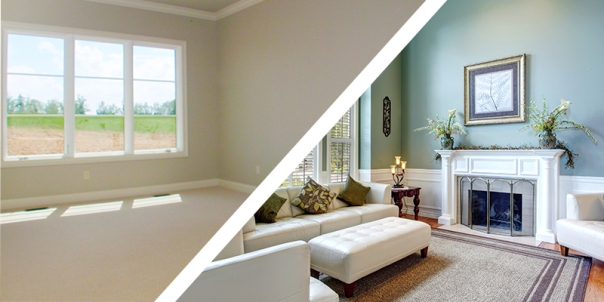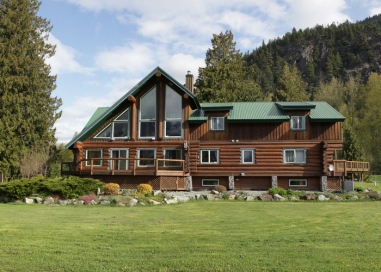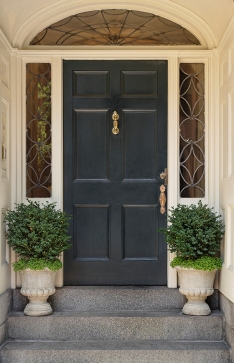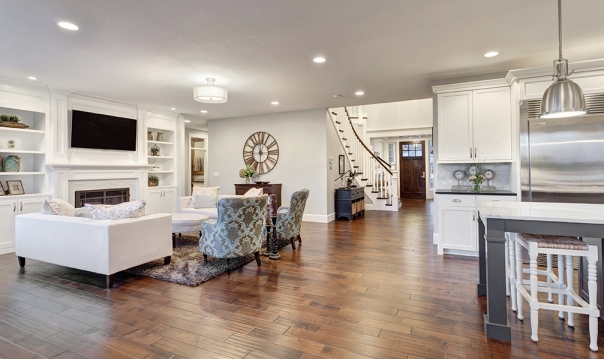Mortgage Interest Rates and Your Buying Power
The majority of people have probably heard about how low mortgage interest rates have been the past couple of years. Over the past decade interest rates on a 30-year fixed mortgage have dropped about 3%. It doesn’t sound like much until you look at just how much it affects your buying power and monthly payment. Take a look at the chart below.

As you can see, a buyer who purchased a home in 2006 for around $170,000 is actually paying almost $170 more a month than a buyer who purchased a home this year for $30,000 more!
Whether you are a first-time home buyer, or looking to move up to a larger, more expensive home, consider doing it now. According to CoreLogic, “prices are projected to appreciate by 5.2% over the next year” and interest rates are projected to increase moderately over the next 12 months. If you are moving to a higher-priced home, it will wind up costing you more in raw dollars (both in down payment and mortgage payment) if you wait. Even a small rate increase of 1.5 percent decreases your buying power by nearly 20 percent for the same monthly payment.
Tolls Coming Soon to Ohio River Bridges Project

We can finally see the light at the end of the tunnel… or should we say bridge? After months and months of construction and changing traffic patterns, the Ohio River Bridges Project is on track to be completed by the end of the year. According to the official Ohio River Bridges website, the purpose of the project is to “to increase cross-river mobility by improving safety, alleviating traffic congestion and connecting highways,” which we all should agree will help stimulate the economy on both sides of the Ohio. Of course, every project requires money and as the construction comes to an end, the new tolling system will begin.
Semonin Realtors recently welcomed guest speaker, Mindy Peterson of RiverLink, to outline the tolling rates and options. RiverLink, the tolling system that will be used on the Brides Project is all-electronic, meaning there will be “no toll booths, no coin machines, no lines, and no stopping”. Tolling will take place on the Abraham Lincoln Bridge, the Kennedy Bridge and the new East End Bridge where sensors and video cameras will be installed.
Toll rates vary by vehicle classification, and drivers can choose between three payment methods.
1. Transponders (Toll fee: $2 for a passenger vehicle)
A transponder is a device that can be place inside your car and communicate with the tolling sensors. So every time you cross a toll bridge, your payment is automatically deducted from your RiverLink account. Drivers can either choose a $15 portable transponder that can be used in multiple cars and used in 16 other states in our region, or they can choose the free transponder sticker that can only be used in one car and only on the three Ohio River toll bridges.
2. Registered License Plate (Toll fee: $3 for a passenger vehicle)
Drivers not using a transponder can register their license plate with the system and set up a prepaid account. Your license plate will be identified by cameras as you cross a toll bridge and withdraw the money from your account. Accounts can be created with a minimum balance of $20 and RiverLink can automatically replenish the account using your credit card, debit card, or checking account when the balance is low.
3. Unregistered License Plate (Toll free: $4 for a passenger vehicle)
For those who do not set up any sort of account will not receive any sort of discount. Each time their car crosses a toll bridge, cameras will photograph the license plate and a bill will be mailed to the registered owner of the vehicle.
These tolls are scheduled to begin by the end of this year! To use the more convenient and lowest cost options, open your RiverLink account today!
2016 – A Historic Year in Real Estate
The landscape of residential housing changed in the fall of 2008. The financial crisis which occurred during this time was finally being felt in the middle of the country, not just on the east and west coast states. Tax credits in 2009 and 2010 were a national attempt to correct the bursting housing bubble. Inventory remained high through the middle of 2011, then inventory was reduced drastically in the latter half of 2011 and on into 2012.
Months of inventory approached more normal levels in the summer of 2012 and then felt the effects of seasonality where months of inventory is lower in spring and summer and higher during the fall and winter. In the spring of 2015 the local market entered a full blown “seller’s market” which is less than 5.5 months of inventory.
The graph below shows a recap of the housing inventory over the last decade. During the spring/summer season of each year we normally see a rise in inventory and a fall during the fall/winter months. This is what creates the mountains and valleys you see in the graph below. However, notice that there is no significant bump in the year 2016. The inventory of residential homes for sale have remained at extremely low levels throughout the entire year, and the months of inventory has reached lows not seen in decades.

It is natural to think the lack in inventory would cause a decrease in sales. However, take a look at the following graphs. In the Greater Louisville, Southern Indiana, and Elizabethtown markets, 2016 has been the best year for sales in a decade!
Note: All three local markets experienced abnormal sales bumps in 2010 due to tax credits offered buyers to stimulate the housing economy that year.
Signs You’re Ready to Sell Your Home
 When people start to outgrow things, they often notice signs that tells them it’s time for a change. So what are some of the signs its time for you to start looking for a new home?
When people start to outgrow things, they often notice signs that tells them it’s time for a change. So what are some of the signs its time for you to start looking for a new home?
Have you ever felt like your home is about to bust at its seams? If you look around and hate how cluttered and overpacked your home looks, first try to sort through and get rid of anything you don’t need or use. If your feeling doesn’t change, it may be a sign its time to move. As families grow, so does our need for space. Assess your financial situation—see how much your current home is worth, how much you still owe on your mortgage, etc.—and determine if you will be able to afford a home with the space you need. Interest rates are still at a historic low, and prices are projected to just keep rising. There will never be a better time to move-up. If you need more space, now is a great time to make the move.
If you feel the very opposite—your home is just too big for your needs now—it could be a sign its time to move. Perhaps your children have moved out and you find yourself with a lot of extra and unused space. Or you find yourself spending way too much time, energy, and money taking care your home’s upkeep and maintenance. These may both be signs your home no longer fits your family’s basic needs and it may be time to downsize.
Has your lifestyle recently changed? Certain life events, such as a new job, a divorce, a new baby, or retirement, can necessitate a change in the way you live your life and the requirements you need fulfilled by a home. If you are looking to spend more time traveling, you may want to purchase a smaller home that requires less maintenance. Or as your get older, or maybe taking care of an aging relative, a home with less stairs might suddenly be important to you. Whatever the reason may be, a change in your lifestyle may be a sign you’re ready to sell your home and move onto something new.
No longer feeling emotionally attached to your home may be another sign you are ready to sell and move on to the next chapter of your life. If this is the case for you, you’ll find it easier to sever ties with your home and the memories you have made there.
Lastly, perhaps you’re now out of debt, with cash in the bank. If you’re not financially ready to move you’re probably not ready to sell.
No single formula can determine when it’s the right time to sell your home. Contact a Semonin Realtor, who can provide honest advice as to what can be best for you, your family, and your budget.
Vacant or Occupied: Which is Better When Selling?

Will a home sell faster and for a better price if it is vacant or occupied? While both options have their own pros and cons, the general consensus is actually that occupied homes sell faster than vacant homes. Let’s take a look at a few reasons why.
Buyers have a harder time visualizing themselves living in an empty home simply because there is no furniture or décor to signify a space’s purpose and functionality. Empty rooms appear to be smaller than they are, but if a bed or dining room table is already in place, buyers won’t have to second guess how such things will fit in the home.
Vacant homes often can appear cold and uninviting. An empty room is really no more than four walls and a ceiling. Many buyers need more than that to really find a space attractive, as well as to keep them from being distracted by any minor flaws with the structure of the home that they might have otherwise not noticed or been discouraged by.
One of the best ways to counteract these negatives is to stage the empty home. Home staging often results in buyers spending more time at showings and makes them feel more comfortable as they look around. On the downside, staging a vacant home does come with the extra expense of renting or purchasing furniture and accessories.
Another downside for selling a vacant home is the home is not being used by the seller who is still responsible for paying for it. Therefore, buyers often “smell a bargain” when looking at a vacant house because they sense they are dealing with a highly motivated seller who might be willing to accept a lower price.
While an occupied home will generally sell faster and for more money, some sellers simply have no choice and must sell a home that is vacant. This option is not without its advantages. While having some furniture and décor in a home is good, having too many personal belongings present can make a home look cluttered. This is unattractive for buyers and may make them concerned about a lack of storage or space. For homes with too much “stuff”, it is usually recommended for the seller to rent a storage unit to temporarily store items they won’t need while they are selling their home, however, this of course is an extra cost that the seller of a vacant home wouldn’t have to worry about. Lastly, sellers might be unwilling or unable to keep the home in turnkey condition for showing purposes. If that is the case, it might be better for the seller to move out before putting the home on the market.
Buying a Vacation Home
Taking a vacation during the summer may get you wishing you could have a home of your own in your favorite travel destination. With interest rates still low, it may be the perfect time to buy that vacation home you’ve been dreaming of. Before starting your search, here are a few things you should consider:
Review your finances. Ask yourself, do you plan to tap the equity in your home? And do you have a cash reserve to cover both the normal and unexpected expenses that come along with home ownership?
Get pre-qualified for long-term mortgage financing. The loan process is similar to that of your primary residence. Having that experience may help you feel more comfortable when applying for a vacation home loan. A down payment of at least 20% is typically required, so be sure you are financially prepared for the purchase.
Research the location you are looking to buy in and talk to people in the area to learn more about what the area has to offer and why they chose to live there. The home values in your vacation spot may be very different than the homes around your primary residence. Analyze these home values and understand what your budget will buy you. Doing this before you start your search will better prepare you for what to expect.
Choose the type of second home you want. Are you looking for a single family home with more privacy? Or a resort-style condo with lots of amenities? Consider the type of lifestyle you live while you are on vacation. Is it different than when you are at home? If you will want to  spend a majority of your time at the vacation home you will want to focus your search on what the actual property offers, whereas, if you will mostly be out exploring the area, perhaps location should be the top priority. It is also important to consider what you want to do with the home when you are not using it. Will you need to hire someone to maintain things like landscaping? Are you interested in renting it out to others? Talk to your REALTOR® about typical rentals in the area to see if this option makes sense for you.
spend a majority of your time at the vacation home you will want to focus your search on what the actual property offers, whereas, if you will mostly be out exploring the area, perhaps location should be the top priority. It is also important to consider what you want to do with the home when you are not using it. Will you need to hire someone to maintain things like landscaping? Are you interested in renting it out to others? Talk to your REALTOR® about typical rentals in the area to see if this option makes sense for you.
Make sure you use a REALTOR® who specializes in vacation properties. If you are looking to purchase a second home, contact your Semonin Realtors! We can connect you with the right REALTOR® in your desired area!
Weekend Home Improvement Projects
Many home improvement projects are easy and inexpensive and can be completed on a weekend. Here are a few simple projects you might want to add to your to-do list:
Update your hardware. Adding new, up-to-date hardware to cabinets and drawers gives them a fresh, new look. You can even go for a little extra impact and replace faucets, light switch covers, and interior doorknobs.
Add a ceiling fan. A ceiling fan can pay for itself by creating less need for air conditioning and making the room more comfortable.
Replace window treatments. This is one of the easiest ways to add a completely new look to a room. Shop around for designs that reflect your personal taste and you will find your living spaces to feel much more like home.
Add garage storage. Explore using shelving, hooks, and hangers to provide more storage space. Removing things like shovels, rakes, and sports equipment off the floor can make it easier to navigate throughout your garage and find what you’re looking for.
Install molding. Crown molding adds an elegant touch to any room, and is a feature that you’ll find to be popular among buyers when it comes time to resale.
 Dress up the front door. Your home’s entrance is the first thing people see when they come to your home, so make it stand out! Adding a coat of fresh paint to your front door, touching up the landscaping, and finishing with some new door hardware plus a welcome mat can do wonders for your home’s curb appeal.
Dress up the front door. Your home’s entrance is the first thing people see when they come to your home, so make it stand out! Adding a coat of fresh paint to your front door, touching up the landscaping, and finishing with some new door hardware plus a welcome mat can do wonders for your home’s curb appeal.
Replace lamp shades. Giving your lamp a face-lift with a new shade is a quick and easy way to redecorate. It can be fun to explore different styles and colors to find the designs that best represent your desired aesthetic.
Weekends are never long enough, but you may be surprised at just how much you can accomplish in a few short days, and just how big of an impact all those little projects can make on your home!
The Perks of Building a Home

Home inventory levels are at historic lows. There simply isn’t much for buyers to choose from, and what is out there is FLYING off the market. Many buyers are facing competitive multiple offer situations, being outbid by another buyer, simply not finding what they need, or not even getting the chance to walk through a property before it’s under contract. There is one solution that many buyers may not have considered, but definitely has its own unique perks—new construction.
Everything is New! When moving into an existing home there’s a chance that hidden costs will arise. A fresh coat of paint, upgrading fixtures, making repairs big and small—the costs can really start to add up. A new home requires less maintenance and already has your preferred design aesthetics, because you were able to pick them out! Which leads us to our next advantage of building your own home:
Design Control. When you build new construction, you design every detail of the house from the ground up. You can literally hand-select everything; the layout, the kitchen cabinets, where electrical outlets are installed etc. No one but yourself knows how you live in your home, so building your own home helps ensure that you will use 100% it. If you don’t have a use for a formal dining room, you don’t have to have one! No wasted space, no unwanted features. When you build, it’s all up to you (and your budget, of course).
It can be better for you and the environment. Many people don’t consider that a new home can literally keep them healthier. A new home is less likely to have the health concerns or toxic materials of older homes (asbestos, mold, lead paint, etc.). New homes are also built with sustainability in mind and are more energy efficient, making them better for the environment and saving you money on energy costs.
Building a home takes time and patience, however if your timetable allows it, you will probably find it to be well worth the wait. Just remember to stay disciplined with your budget, choose a builder you can trust, and think of the level of satisfaction and accomplishment you’ll feel when you spend your first night in the finished product.
Avoiding Common Seller Mistakes

When it comes to selling your home it is important to view it as the product it now is. To sell your home in the shortest amount of time and for the best possible price, you will want to avoid these common mistakes some sellers make.
- Not understanding the current market conditions can make it difficult to determine a good asking price for your home. Realtors are well versed in the local market conditions and can help educate you on the things you need to know to decide the best asking price.
- Overpricing a home is a common mistake some sellers make when they try to sell their home without the help of a Realtor—one that will only help sell more reasonably priced homes in the neighborhood.
- As a seller, you are legally required to disclose any defects that you are aware of. Undisclosed issues will likely be discovered anyway during a home inspection, causing a deal with a buyer to possibly fall through and leave you back at square one. It is important to have everything out on the table from the start to avoid potential problems happening later in the selling process.
- Not taking the time to prepare your home can keep good offers from rolling in. Thoroughly clean and declutter your home and remember that first impressions are critical so keep the exterior of your home tidy and well maintained to maximize curb appeal. While your home is for sale it is also a good idea to avoid creating strong cooking smells in case any impromptu showings come up, and removing any pet odors is an absolute must!
Call your Realtor to walk through your home with you and point out items that require your attention in order to make the selling process as successful as possible.
Preparing to Buy? Get Financing First!
Once upon a time, buyers found their dream home and then went in search of a mortgage. Today things have changed. The market is more competitive, and buyers who arrange their financing first have a distinct advantage. This means finding a lender before you start looking for a home.
1. Talk to several reputable lenders.
Keep in mind that there are all kinds of mortgages available with different rates and different features. Meeting with multiple loan officers will help you navigate through all the options.
2. Get pre-approved for a mortgage.
Unlike pre-qualification, which is simply a quick estimate of your borrowing potential, pre-approval is a formal approval of a specific mortgage amount – typically the maximum you can borrow. And you’ll receive a Good Faith Estimate of your closing expenses. By initiating the mortgage process early, you’ll be in a better position for your search and purchase.
3. Shop with confidence.
Once you’re pre-approved, you’ll know exactly how much house you can afford, and you’ll have an edge over other buyers in multiple-offer or negotiating situations.
Already pre-approved? It pays to compare! HomeServices Lending wants to offer you a $50 Reward Card just for getting their second opinion. CLICK HERE for details!



